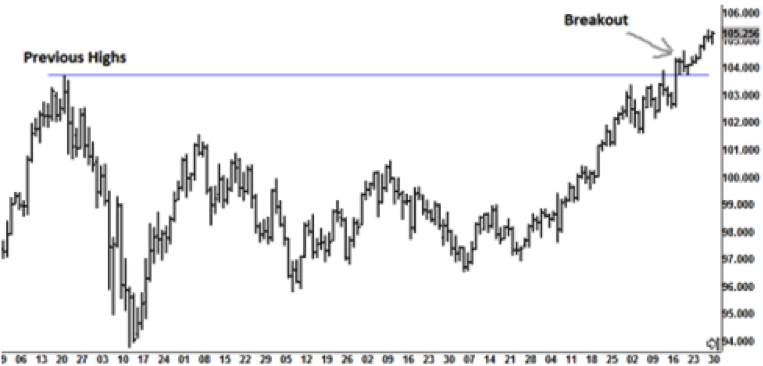Simple 3-step swing trading for specimen hunters
Here’s a question I get asked on a regular basis: How can I fit trading in around my job and still make consistent profits without having to check charts during the day?
The good news is: there are loads of ways!
The trick, of course, is finding the way that has ‘your name’ on it – the method that fits your personality best. 
Now trading ‘end-of-day’ (that’s where you check your charts and manage your orders in the evening, after work) is a common situation amongst home-based traders. And it can be a very effective way to go about things. The fact you’re not sitting in front of the charts all day long can actually be a blessing in its own right. It stops you fiddling around with your orders before the right time!
The problem is many traders confuse activity with effectiveness. They think they need to be busy placing bucket-loads of trades all the time. And they panic a bit at the thought of only checking the chart once per day: but how am I ever going to be able to find ENOUGH trades to make my big profits?
It’s like being busy somehow equates to profitability. But maybe modern society has conditioned us to think like this. A throwback to a ‘manufacturing’ mindset where the more widgets your factory cranks out in a day, the more money you make.
But trading is a very different proposition. In fact, the best trade you ever make could be one you only close months, or even years, after you first opened it.
Yes, a single trade could actually be responsible for the lion’s share of your annual profits!
Think about it: if you ran a strategy with a positive statistical edge and let the profits run, it would only be a matter of time before you hooked into a really good specimen of a trade.
There’d be the matter of risk control, of course. You’d need to manage the stop loss somehow. But a common pattern of results for a strategy like this might be to see a series of small winning trades and small losing trades and then BAM! A huge whale of a trade comes along that you manage to hang onto that sends your net returns through the roof.
So how might you go about trading like this?
Why, I’m glad you asked. Let me remind you what swing trading is all about…
Simple 3-step swing trading for end-of-day traders
1) Find an eye-opening event.
First of all you want to find a price-action pattern that suggests either a potential reversal or one that anticipates a continuation of the current market direction.
And the world of technical analysis is at your disposal here. Choose any of your favourites. You can even specialise in just one pattern and be a very successful swing trader. You can look out for double tops, head and shoulders patterns, breakouts to new highs, doji reversals… and that’s just scratching the surface.
(If any of the price patterns I mentioned are new to you, or if you’d like to explore deeper, I’d recommend Murphy’s Technical Analysis of the Financial Markets as your go-to reference book.)
Next, once you’ve had your eyes opened to a potential opportunity, you monitor for a confirmation. You want to see a pullback before you attempt to enter the trade.
2) Pullback and Entry. Most successful swing trades will occur in a high-momentum environment once the market has already indicated its next probable move (via the ‘eye opening’ event).
Your job now is to patiently wait until the market makes a small pullback or pause. This gives you chance to enter a trade strategically with a carefully calculated (and very limited) exposure to risk.
In an example of a breakout to new highs (see below) you might patiently wait until the initial volatility dies down, the move higher slows and eventually pauses for at least a bar. You’d now be poised to enter your long trade once the market continues higher again, breaking out above the ‘pause’ bars.
You can do this by leaving a stop-entry order working with your broker that gets you into your position automatically. You don’t need to sit watching.
Next, once you’re in, you need to manage your trade with a Target and Trail exit strategy…
3) Target and Trail. You’ve found an eye-opening event, you’ve had it confirmed by the little pause or pullback, and the market now looks ready to soar again to new highs…
You can use a retest of the recent breakout high as your first technical target – it’s the logical place for the market to strive to reach next.
By doing so, you’re letting the market prove it’s going to try and do what you suspect. You’ve got a high probability initial target to use to take some fast profits and you can also use that as your signal to move your stop to break even. You’d then let the trade run and hang on for as long as you can (via a sensible trailing-stop loss strategy).
So let’s pull all the theory together now and look at the chart for an example swing trade.
First of all this is the eye-opening event. It’s a breakout above recent highs:
And here’s a close-up of the swing trade in action:
A = False breakout. The market takes out the highs but can’t keep it up there. No opportunity yet.
B = Here’s the eye-opening event. The market breaks out above the old highs and holds its ground. We’re now waiting for the pullback as confirmation to try and enter a trade.
C = Here’s the pull back. We want to enter on a breakout above the bar labelled C with an initial technical target of the highs of the bar market B. That’s where the market will try to reach as a first port of call.
Here’s a close-up of the trade management:
The entry point is a break above bar C. The initial target is the high of bar B – the market will try to go there to keep the up-move intact.
So your initial stop in this case could be placed below the bar marked C. (I would suggest using a default 1:1 risk/reward ratio in cases where stop placement is not obvious from the price action alone.)
You can see the thrust upwards after entry into this trade…
It takes out the target within three bars – a 53 pip move. And once the target is reached you should consider taking some money off the table, trailing your stop up to breakeven at least. The move may continue upwards for days to come, but who knows for sure?
Keep the upside potential in play but don’t risk watching your paper profits disappear by holding out for too long!
The ‘whale trades’ will come. But not every single time! The secret is simply to keep yourself in the game and you’ll catch them sure enough when the time is right.
Be Prepared: Market Moving Data Coming This Week (London Time)
Wednesday 4th May
09:30 GBP Construction PMI
13:15 USD ADP Non farm Employment change
15:00 USD ISM Non manufacturing PMI
15:30 USD Crude Oil Inventories
Thursday 5th May
09:30 GBP Services PMI
Friday 6th May
13:30 USD Job numbers!
Monday 9th May
– no big reports
Tuesday 10th May
– no big reports
So the monthly American job numbers is the big market driver this week. Be ready and alert at lunchtime on Friday!
Trade safe and I’ll catch you next week.
Happy trading!



